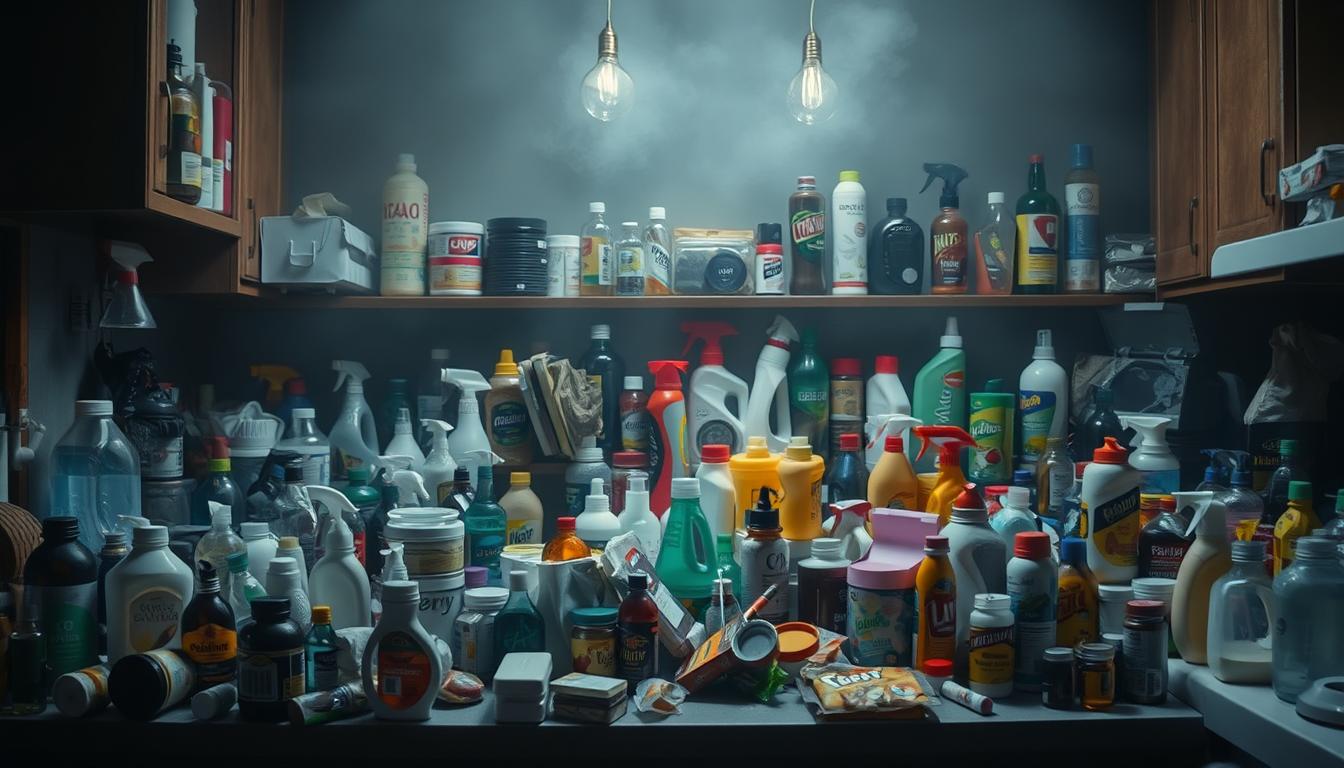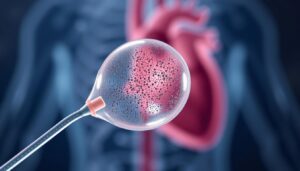Every day, women unknowingly face invisible chemical threats that can upset their hormonal balance. These endocrine disruptors hide in everyday products, quietly messing with our body’s delicate hormonal system1. They can harm women’s health in ways most people don’t even think about.
Our homes are filled with chemicals that can harm our hormonal health. From personal care items to kitchen containers, endocrine disruptors are everywhere. They mimic natural hormones, tricking our body’s complex systems. Women are especially at risk from these hidden chemical invaders.
Studies show that many common household products contain substances that can mess with our hormonal balance. These chemicals can affect fertility, metabolism, and reproductive health. They pose long-term risks that many people don’t know about.
Key Takeaways
- Endocrine disruptors are prevalent in everyday household products
- Chemical compounds can interfere with natural hormonal processes
- Women are particularly susceptible to hormonal disruptions
- Many household items contain hidden chemical threats
- Understanding these risks is crucial for protecting women’s health
Understanding the Endocrine System and Hormonal Balance
The human body has a complex network called the endocrine system. It keeps hormones in balance and controls important body functions. Over 70 hormones work hard in our body, managing everything from how we burn energy to how we feel2.
This system uses special glands to make and send hormones into the blood. These messengers travel all over the body, controlling key functions and keeping us healthy2.
The Brain’s Hormonal Command Center
The brain is the main boss of hormones, with the hypothalamus and pituitary gland leading the way. They talk to other glands, making sure hormones are made right and in the right amounts.
Key Endocrine Glands and Their Functions
- Thyroid Gland: Regulates metabolism and energy production
- Adrenal Glands: Manage stress response and produce cortisol
- Pancreas: Controls blood sugar through insulin and glucagon
- Reproductive Glands: Produce sex hormones essential for development
Hormones: Daily Body Function Controllers
Hormones are key to managing our daily lives. They affect sleep, hunger, mood, and reproductive health3.
| Hormone | Primary Function | Impact |
|---|---|---|
| Estrogen | Reproductive Health | Regulates menstrual cycle |
| Cortisol | Stress Response | Manages fight-or-flight mechanisms |
| Insulin | Metabolic Regulation | Controls blood sugar levels |
Knowing about the endocrine system shows how vital it is to keep hormones balanced. It helps us protect against problems2.
Common Chemical Culprits in Personal Care Products
Women’s daily beauty routines expose them to hidden chemical risks. The average woman uses many toxic cosmetics without knowing the health risks4. Up to 90% of personal care products may have endocrine-disrupting chemicals, affecting hormones.
Choosing skincare ingredients wisely is crucial4. About 30% of women have had bad reactions to products with parabens, a common preservative that can mess with hormones.
Dangerous Ingredients Lurking in Your Cosmetics
There are many hidden dangers in our daily beauty routines. Some of the most dangerous ingredients include:
- Phthalates:4Found in 75% of personal care products
- Triclosan: An antibacterial agent linked to hormone disruption
- Synthetic fragrances:4Can introduce up to 100 different chemicals through skin absorption
Hidden Toxins in Skincare Products
470% of personal care products marketed to women contain at least one chemical known to be a reproductive toxicant. This shows how important it is to know what we put on our bodies.
The Truth About “Natural” Labels
Not all “natural products” are the same4.50% of consumers are willing to pay more for chemical-free options. This trend is expected to grow 10% every year until 2030.
Recommendation: Always read ingredient lists carefully and research product components to protect your health.
Kitchen Hazards: From Cookware to Food Storage
Your kitchen might be hiding health risks. These come from toxic cookware and chemicals in food packaging. Everyday items can expose you to harmful substances that affect your hormones.
Non-stick cookware is a big risk because of PFAS. These chemicals can mess with your hormones. They can get into your food, especially when pans get hot or wear out5.
- Avoid scratched non-stick surfaces
- Replace cookware showing signs of coating breakdown
- Choose ceramic or cast iron alternatives
Food packaging chemicals are also a big threat. Plastic containers, like those made with polycarbonate and epoxy resins, can release xenoestrogens. These mimic hormones and can build up in your body over time. They might mess with your hormones6.
| Cookware Type | Potential Risks | Safer Alternatives |
|---|---|---|
| Non-stick Pans | PFAS Exposure | Ceramic Cookware |
| Plastic Containers | Xenoestrogen Leaching | Glass Storage |
To stay safe, choose cookware and storage that don’t leak chemicals. Go for glass, stainless steel, or ceramic. These options lower the risk of toxic chemicals getting into your food7.
The Impact of Endocrine Disruptors on Women’s Health
Endocrine disruptors are a big problem for women’s health. They quietly mess with our hormones. These chemicals can cause many health issues that affect women in many ways2. Women are exposed to harmful chemicals every day through products we use, which can harm our hormones for a long time8.

Fertility and Reproductive Challenges
Endocrine disruptors really hurt women’s reproductive health. Research shows they can raise the risk of reproductive problems by up to 30%8. About 10% of women in the U.S. struggle with infertility, and studies link this to chemical exposure8.
- Increased risk of polycystic ovary syndrome (PCOS)
- Higher incidence of endometriosis
- Potential disruption of hormonal reproductive cycles
Thyroid Function Disruption
Long-term exposure to endocrine disruptors can lead to thyroid problems. These chemicals mess with hormone production, causing big changes in metabolism2. This can lead to thyroid issues that really affect our health2.
The body’s hormonal system is incredibly complex, with over 70 active hormones regulating critical bodily processes2.
Metabolic Changes and Weight Gain
Endocrine disruptors can cause metabolic changes that lead to weight gain. Studies show they can mess with our body’s natural weight control2. Women who use many personal care products daily might be exposed to about 1.2 million micrograms of harmful chemicals every year8.
Being aware and reducing chemical exposure is key to keeping our hormones healthy.
Bathroom Cabinet Dangers: Personal Care Product Analysis
Your bathroom cabinet might be hiding a chemical minefield. These toxic personal care products could disrupt your hormonal balance. Many everyday toiletries contain dangerous endocrine-disrupting chemicals. These chemicals can penetrate your skin and potentially impact your overall health9.
The most concerning bathroom chemicals often lurk in seemingly harmless products like:
- Lotions and moisturizers
- Makeup and cosmetic products
- Shampoos and conditioners
- Deodorants and antiperspirants
Parabens, phthalates, and synthetic fragrances are prime examples of ingredients that can act as hormone disruptors. These chemicals can mimic estrogen in the body, potentially leading to various health complications9.
When searching for safe toiletries, consumers should be vigilant about reading ingredient labels. Look for products that are:
- Free from synthetic fragrances
- Paraben-free
- Phthalate-free
- Developed with natural ingredients
Choosing clean, non-toxic personal care products is crucial for maintaining hormonal health. It also reduces potential long-term risks associated with chemical exposure9.
Safe Alternatives for Kitchen and Bathroom Products
Keeping your health safe starts with smart choices in daily products. It’s important to research natural beauty products, safe cookware, and non-toxic storage10.
Natural Personal Care Options
Many personal care products have harmful chemicals that can mess with your hormones. Women looking for safer options should check out these natural beauty products:
- Organic skincare made with plant-based ingredients
- Mineral-based makeup without synthetic preservatives
- Essential oil-based fragrances
Chemicals in products can quickly get into your blood through your skin10. It’s key to pick products that are safe and natural. Look for brands that are open about what’s in their products.
Non-Toxic Cookware Choices
Your kitchen cookware is important for avoiding chemicals. Here are some safe cookware options:
| Material | Benefits | Potential Concerns |
|---|---|---|
| Cast Iron | Naturally non-stick, adds iron to food | Requires specific maintenance |
| Ceramic | Zero chemical coating, even heating | Can be fragile |
| Stainless Steel | Durable, non-reactive | Can be more expensive |
Safe Food Storage Solutions
Keeping your food safe means using non-toxic storage containers. Glass and stainless steel are great alternatives to plastic, stopping chemicals from leaking into your food.

By picking natural beauty products, safe cookware, and non-toxic storage, you can lower your risk of harmful chemicals10.
Understanding Product Labels and Chemical Ingredients
Looking at product ingredient lists can be tough. There are over 80,000 chemicals in the U.S., some bad for our health11. It’s key to know what’s in products to choose wisely.
Figuring out ingredient lists needs some know-how. Sugar alone has more than 56 names on labels, making it hard to spot. Chemical names can seem scary, making it hard to pick healthy options.
- Learn to recognize common chemical prefixes
- Research ingredients you don’t understand
- Use smartphone apps for quick ingredient verification
- Look for transparent labeling
Some chemicals are really worrying. BPA, for example, is found in over 92% of Americans’ urine11. Triclosan levels went up by 50% from 2004 to 2010, with 75% of hand soaps containing it11.
| Chemical Type | Common Sources | Potential Health Risks |
|---|---|---|
| Phthalates | Household products | Insulin resistance |
| BPA | Plastic containers | Hormone disruption |
| Triclosan | Antibacterial soaps | Endocrine system interference |
Knowing about ingredients and chemical names is the first step to safer choices. Always check labels and choose products with clear, easy-to-read ingredients.
Detoxifying Your Home Environment
Creating a chemical-free home needs careful planning and awareness. Home detox helps us spot hidden toxins in our daily lives. Women face a high risk from endocrine disruptors, with about 120 chemicals from personal care products daily12.
The U.S. introduces 60,000 to 80,000 new chemicals yearly, many untested12. A good strategy for a healthy home must tackle all areas. We need to watch out for microplastics in foods and drinks, showing the need for quick action13.
To detox your home, switch to natural personal care items and choose safe cookware. Always check labels for harmful chemicals. Avoiding PFAS in products is key, as 96% of teens have it in their bodies12. Cutting down on harmful substances can greatly lower your risk of endocrine disruptors.
Turning your home into a wellness space takes effort and smart choices. Begin with small changes in each room. This builds a strong plan to reduce toxic chemicals. Your work towards a healthier home is a big step towards better health.




